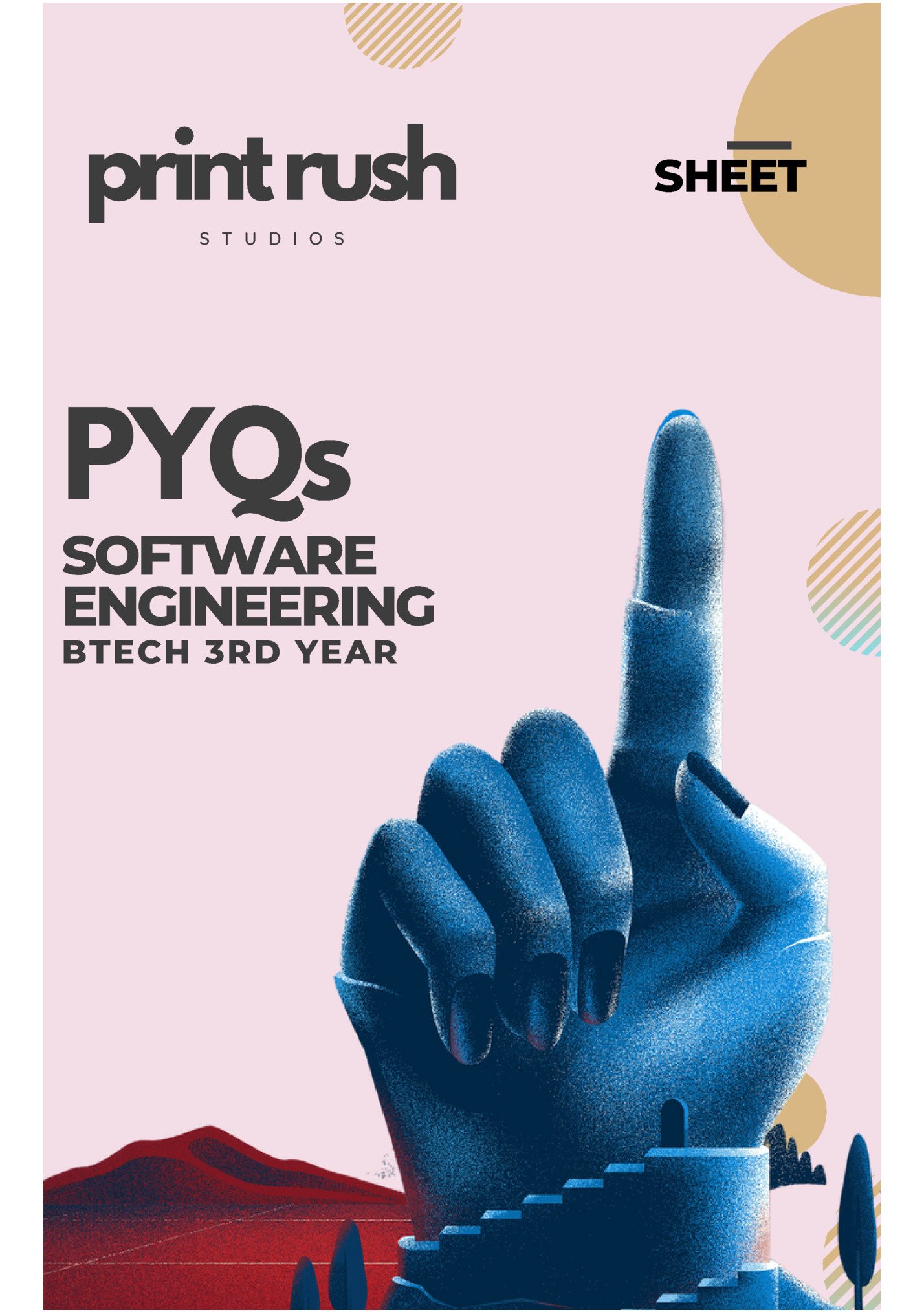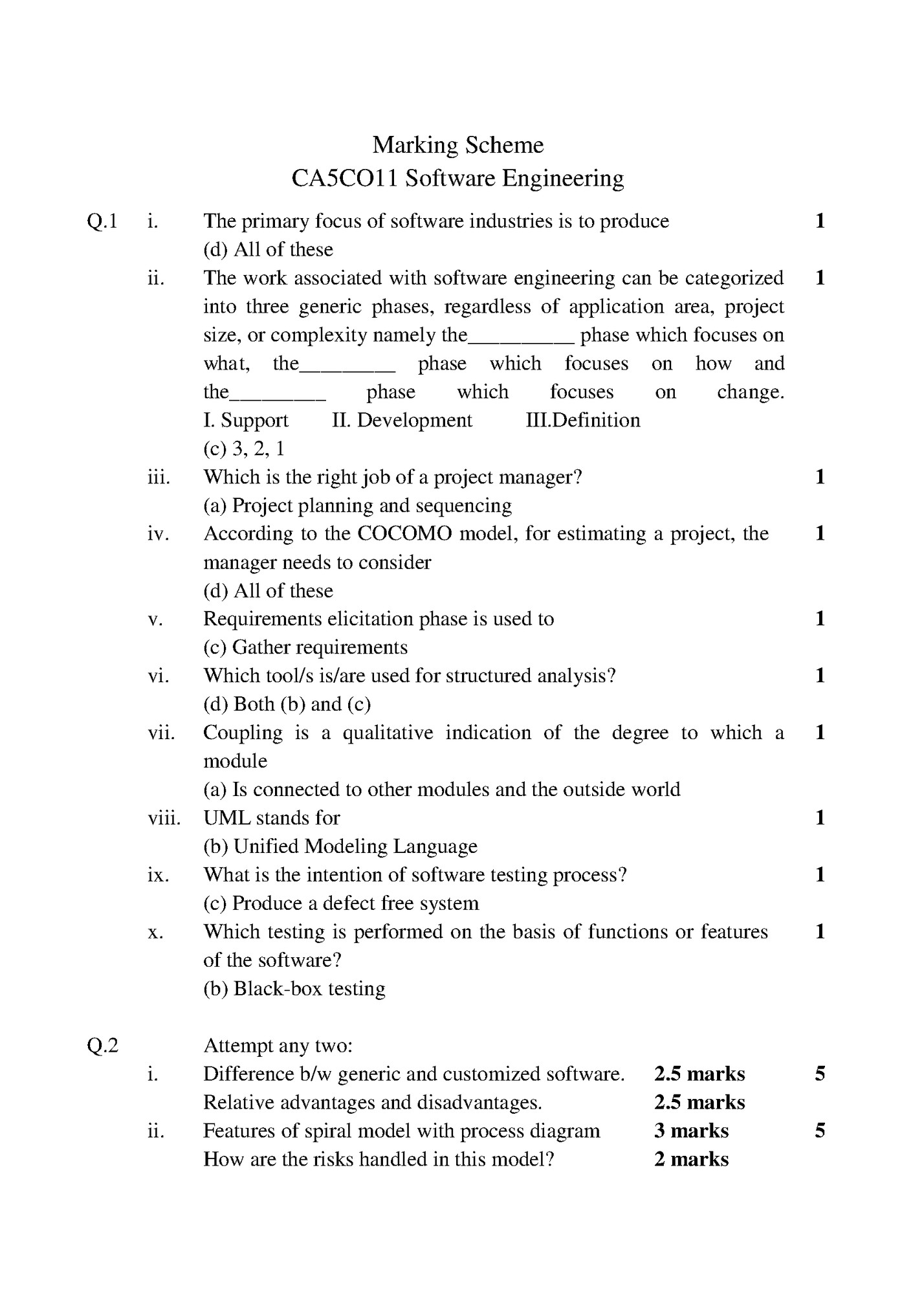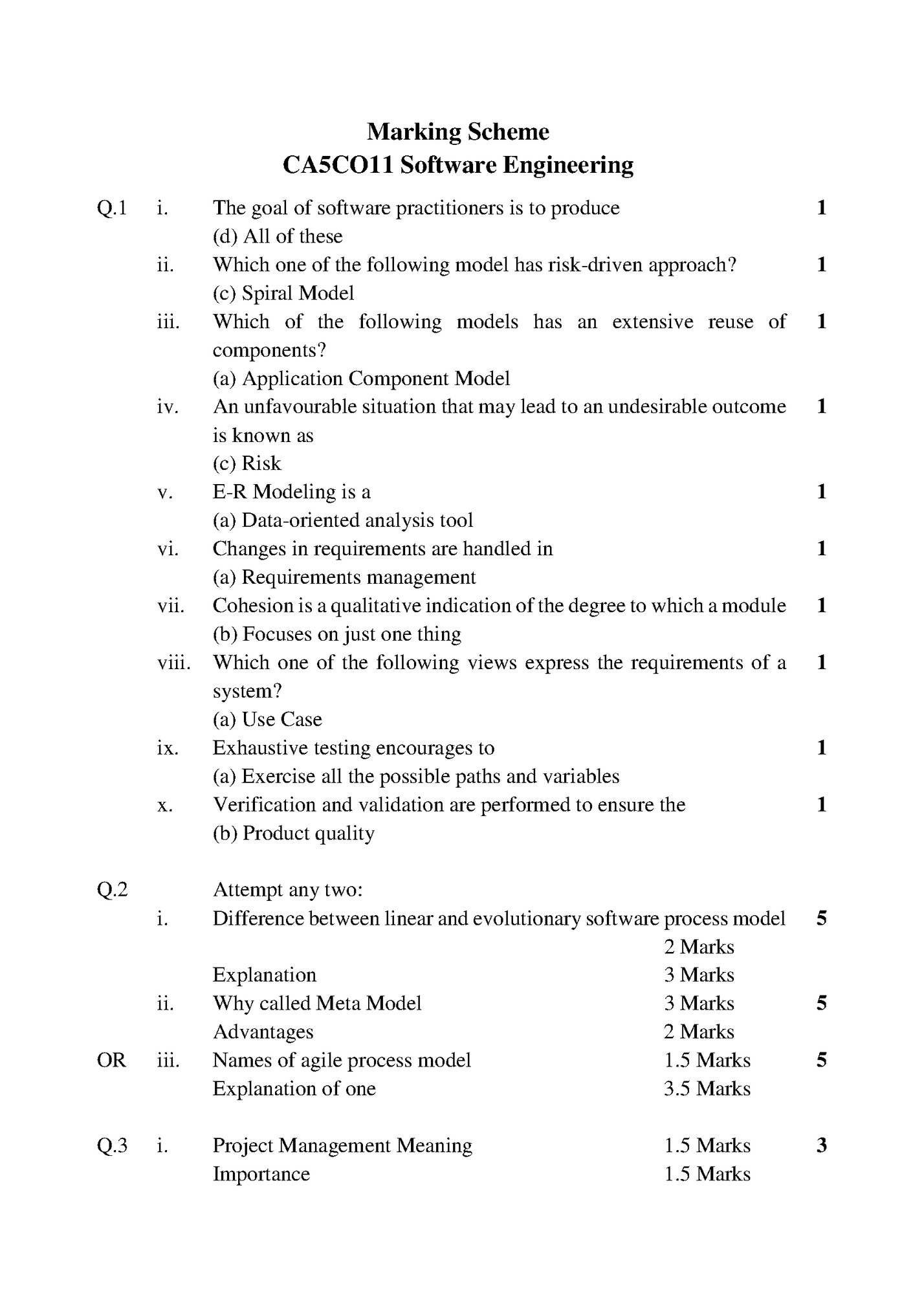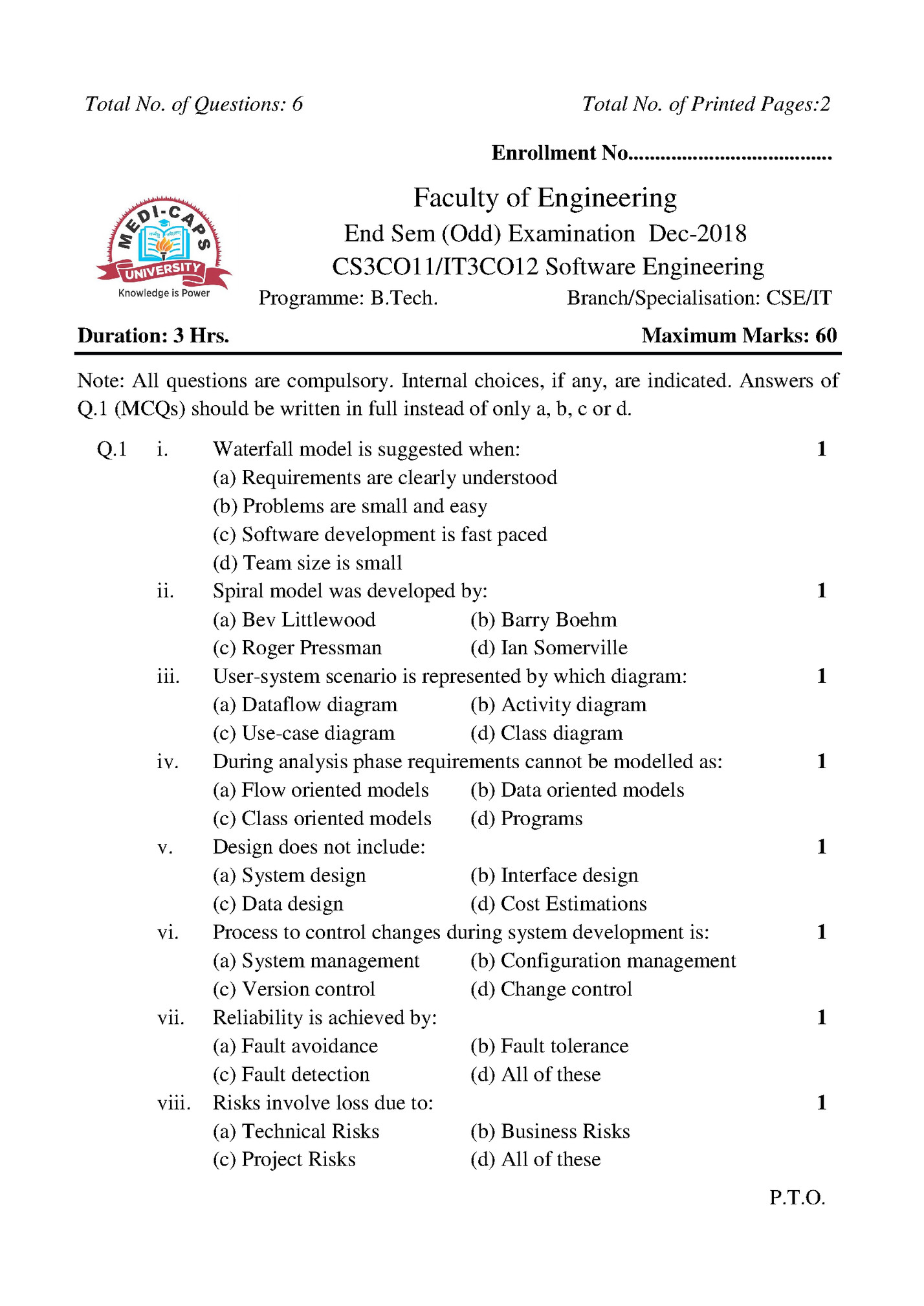S T U D I O S PYQs SOFTWARE ENGINEERING BTECH 3RD YEAR SHEET

Total No. of Printed Pages:3 Enrollment No...................................... Faculty of Engineering End Sem (Odd) Examination Dec-2018 CA5CO11 Software Engineering Programme: MCA Duration: 3 Hrs. Branch/Specialisation: Computer Application Maximum Marks: 60 Note: All questions are compulsory. Internal choices, if any, are indicated.Answers of Q.1 (MCQs) should be written in full instead of only a, b, c or d. Q.1 i. ii. iii. iv. The primary focus of software industries is to produce (a) Quality Software (b) Software within Budget (c) Software in small cycle time (d) All of these The work associated with software engineering can be categorized into three generic phases,regardless of application area, project size, or complexity namely the__________ phase which focuses on what, the_________ phase which focuses on how and the_________ phase which focuses on change. I. Support II. Development III. Definition (a) I, II, III (b) II, I, III (c) III, II, I (d) III, I, II Which is the right job of a project manager? (a) Project planning and sequencing (b) Requirement analysis (c) Testing (d) Architecting According to the COCOMO model, for estimating a project, the manager needs to consider (a) Characteristics of the product (b) Experience of the development team (c) Characteristics of the development environment (d) All of these 1 1 1 1 P.T.O.

v. vi. vii. viii. ix. x. Q.2 i. ii. iii. Requirements elicitation phase is used to (a) Organize requirements (b) Validate requirements (c) Gather requirements (d) Manage requirements Which tool/s is/are used for structured analysis? (a) UML (b) DFD (c) Data Dictionary (d) Both (b) and (c) Coupling is a qualitative indication of the degree to which a module (a) Is connected to other modules and the outside world (b) Focuses on just one thing (c) Is able to complete its function in a timely manner (d) Can be written more compactly UML stands for (a) Universal Modeling Language (b) Unified Modeling Language (c) Unified Meta Language (d) None of these What is the intention of software testing process? (a) Produce a maintainable system (b) Produce a usable system (c) Produce a defect free system (d) None of these Which testing is performed on the basis of functions or features of the software? (a) White-box testing (b) Black-box testing (c) Regression testing (d) Performance testing Attempt any two: Explain the difference between generic and customized software. What are their relative advantages and disadvantages? Explain the features of spiral model with the help of its process diagram? How are the risks handled in this model? What is extreme programming? What are its different practices of development? [3] 1 Q.3 i. ii. 1 OR iii. Q.4 i. OR ii. iii. 1 1 1 Q.5 i. ii. OR iii. 1 Q.6 5 i. 5 ii. iii. Explain risk management process. What are the responsibilities of a project manager in an organization? What skills are necessary for a project manager? Compute the FP value for vehicle registration at your nearest RTO office. Assume that it is an average complexity size project. The information domain values are as follows: Number of inputs: 6 Number of outputs: 7 Number of inquiries: 5 Number of external files: 9 Number of interfaces: 4. Assume that all complexity adjustment values are average and 9 algorithms have been counted. 4 6 What is the purpose of fact finding? Explain the various methods of fact finding in brief. Explain the desirable characteristics of a good SRS document. Differentiate between structured analysis and object-oriented analysis with suitable examples. 4 Enumerate the characteristics of a good software design. What is cohesion? Why is cohesion important in software designing? Explain the different types of cohesion with their example. What is the purpose of use case diagrams? Draw a use case diagram for a library management system. Attempt any two: What is software testing? Why is it most important and serious phase in software development life cycle? Differentiate between white-box and block-box testing methods. Explain the various software quality factors with example. 5 ****** 6 6 6 3 7 7 5 5 5
![[2] [2]](./files/493e0eab25b3379b29d2c4691850b57f/small_images/pg_3-L-0.jpg)
Marking Scheme CA5CO11 Software Engineering Q.1 i. ii. iii. iv. v. vi. vii. viii. ix. x. The primary focus of software industries is to produce (d) All of these The work associated with software engineering can be categorized into three generic phases, regardless of application area, project size, or complexity namely the__________ phase which focuses on what, the_________ phase which focuses on how and the_________ phase which focuses on change. I. Support II. Development III.Definition (c) 3, 2, 1 Which is the right job of a project manager? (a) Project planning and sequencing According to the COCOMO model, for estimating a project, the manager needs to consider (d) All of these Requirements elicitation phase is used to (c) Gather requirements Which tool/s is/are used for structured analysis? (d) Both (b) and (c) Coupling is a qualitative indication of the degree to which a module (a) Is connected to other modules and the outside world UML stands for (b) Unified Modeling Language What is the intention of software testing process? (c) Produce a defect free system Which testing is performed on the basis of functions or features of the software? (b) Black-box testing 1 Q.3 1 Extreme programming. Different practices of development. i. Risk management process 1 mark for each activities ii. OR 1 iii. Q.4 i. 1 ii. OR iii. Q.5 i. ii. OR iii. 1 1 1 1 1 Q.6 i. 1 ii. iii. Q.2 i. ii. Attempt any two: Difference b/w generic and customized software. Relative advantages and disadvantages. Features of spiral model with process diagram How are the risks handled in this model? 2.5 marks 2.5 marks 3 marks 2 marks 5 4 (1 mark * 4) Responsibilities of a project manager in an organization. 2 marks Necessary skills of project manager 4 marks Calculating Unadjusted Function Points (UFP) 2.5 marks Calculating complexity adjust. attributes (CAA) 2.5 marks Calculating Function Points (FP) 1 marks 6 6 Purpose of fact finding 1 mark Various methods 3 marks Characteristics of a good SRS document. 1 mark for explanation of each (1 mark * 6) Difference b/w structured analysis and object-oriented analysis Each pair of differentiation and example (2 marks * 3) 4 1/2 mark for each characteristics Definition of cohesion. Importance of cohesion Explanation of different types of cohesion Purpose of use case diagrams Diagram of library management system 3 7 (1/2 mark * 6) 1 mark 2 marks 4 marks 3 marks 4 marks Attempt any two: Defining software testing 2 marks Highlighting its importance 3 marks Difference between white-box and block-box testing methods. 1 mark for each difference (1 mark * 5) Various software quality factors with example. 1 mark for each factor with example (1 mark * 5) 5 ****** 5 2 marks 3 marks 6 6 7 5 5 5

Total No. of Printed Pages:3 Enrollment No...................................... Faculty of Engineering End Sem (Odd) Examination Dec-2019 CA5CO11 Software Engineering Programme: MCA Duration: 3 Hrs. Branch/Specialisation: Computer Application Maximum Marks: 60 Note: All questions are compulsory. Internal choices, if any, are indicated. Answers of Q.1 (MCQs) should be written in full instead of only a, b, c or d. Q.1 i. ii. iii. iv. v. vi. The goal of software practitioners is to produce 1 (a) Cost-Effective Products (b) Faster Products (c) Better Products (d) All of these Which one of the following models has risk-driven approach? 1 (a) Agile Process Model (b) Prototyping Model (c) Spiral Model (d) Waterfall Model Which of the following models has an extensive reuse of 1 components? (a) Application Component Model (b) Early Design Model (c) Post-Architecture Model (d) None of these An unfavourable situation that may lead to an undesirable outcome 1 is known as (a) Failure (b) Unreliability (c) Risk (d) None of these E-R Modeling is a 1 (a) Data-oriented analysis tool (b) Object- oriented analysis tool (c) Structured analysis tool (d) Prototype analysis tool 1 Changes in requirements are handled in (a) Requirements management (b) Requirements development (c) Requirements analysis (d) Requirements specification P.T.O.

vii. viii. ix. x. Cohesion is a qualitative indication of the degree to which a module (a) Can be written more compactly (b) Focuses on just one thing (c) Is able to complete its function in a timely manner (d) Is connected to other modules and the outside world Which one of the following views express the requirements of a system? (a) Use Case (b) Design (c) Process (d) Implementation Exhaustive testing encourages to (a) Exercise all the possible paths and variables (b) Exercise limited paths and variables (c) Exercise only the conditional statements (d) None of these Verification and validation are performed to ensure the (a) Design Quality (b) Product quality (c) Product measure (d) All of these [3] 1 OR iii. Explain risk management process. Discuss the various risk planning activities. 7 Q.4 i. ii. 3 7 OR iii. Distinguish between functional and non functional requirements. Why do we need requirements validation? Explain the various methods of requirements validation with their pros and cons. What are the advantages of prototyping over traditional approaches for requirements analysis? Differentiate between throwaway and evolutionary prototyping. Q.5 i. ii. 2 8 OR iii. What is the purpose of use case diagram? What is coupling? Why is the coupling important in software designing? Explain different types of coupling with their example. Explain Design Principles. Enumerate characteristics of a good software design. 1 1 1 Q.6 Q.2 i. ii. iii. Q.3 i. ii. Attempt any two: What is the basic difference between linear and evolutionary software process model? Explain. Explain spiral model. Why is the spiral model called meta model? What are its advantages. Name the different agile process models. Explain one of them in detail. What do you mean by project management? Explain its importance. Suppose a system for office automation must be designed. For the requirements, it was clear that there will be four major modules in the system: data entry (0.6 KDLOC), data update (0.6 KDLOC), query (0.8 KDLOC), and report generator (1.0 KDLOC). It is also clear from the requirements that this project will fall in the organic category. From the requirements, the ratings of the different cost driver attributes were assessed as follows: complexity (high- 1.15) storage (high- 1.06), experience (low- 1.13) programmer capability (low- 1.17). Determine the effort required to develop the software product and the nominal development time? 5 i. ii. 5 iii. Attempt any two: Discuss and differentiate between verification and validation. Define error, defect, and failure with suitable example. What is relationship among these. Differentiate fault and failure. Explain system testing. Why are different tests needed to test the system? 5 ****** 3 7 7 8 5 5 5
![[2] [2]](./files/493e0eab25b3379b29d2c4691850b57f/small_images/pg_6-L-0.jpg)
Marking Scheme CA5CO11 Software Engineering Q.1 i. ii. iii. iv. v. vi. vii. viii. ix. x. The goal of software practitioners is to produce (d) All of these Which one of the following model has risk-driven approach? (c) Spiral Model Which of the following models has an extensive reuse of components? (a) Application Component Model An unfavourable situation that may lead to an undesirable outcome is known as (c) Risk E-R Modeling is a (a) Data-oriented analysis tool Changes in requirements are handled in (a) Requirements management Cohesion is a qualitative indication of the degree to which a module (b) Focuses on just one thing Which one of the following views express the requirements of a system? (a) Use Case Exhaustive testing encourages to (a) Exercise all the possible paths and variables Verification and validation are performed to ensure the (b) Product quality 1 OR iii. 1 i. ii. OR iii. Q.3 i. Attempt any two: Difference between linear and evolutionary software process model 2 Marks Explanation 3 Marks Why called Meta Model 3 Marks Advantages 2 Marks Names of agile process model 1.5 Marks Explanation of one 3.5 Marks Project Management Meaning Importance 1.5 Marks 1.5 Marks 0.5 Marks 2.5 Marks 1.5 Marks 2.5 Marks 7 7 4 Marks 3 Marks 1 Q.4 1 i. ii. OR iii. Q.5 i. ii. 1 Distinguish between functional and non functional requirements. 0.75 Marks for each difference (0.75 mark *4) Meaning of requirement validation 3 Marks Methods of Requirements Validation 4 Marks Advantages of prototyping 3 Marks Difference b/w throwaway and evolutionary prototyping 4 Marks 3 Purpose of use case diagram Coupling Importance of coupling Different types of coupling Design Principles 0.5 each principle (0.5 mark * 8) Characteristics 0.5 for each (0.5 mark * 8) 2 8 7 7 1 1 1 OR iii. 2 Marks 2 Marks 4 Marks 4 Marks 4 Marks 8 1 Q.6 1 i. ii. Q.2 Calculation of KLOC Use of Intermediate COCOMO Model formula Calculation of EAF Use of Time estimation formula Risk management process 1 Mark for each process step (1 mark * 4) Risk planning activities 5 iii. Attempt any two: Discursion Difference b/w verification and validation Definition error, defect, and failure with example Relationship among these. System Testing Different Tests needed to test the system. 5 ****** 5 3 2 Marks 3 Marks 5 5 3 Marks 2 Marks 2 Marks 3 Marks 5

[2] Total No. of Printed Pages:2 Enrollment No...................................... ix. Faculty of Engineering End Sem (Odd) Examination Dec-2018 CS3CO11/IT3CO12 Software Engineering Programme: B.Tech. Duration: 3 Hrs. x. i. ii. iii. iv. v. vi. vii. viii. 1 1 (d) Defect rate Branch/Specialisation: CSE/IT Waterfall model is suggested when: (a) Requirements are clearly understood (b) Problems are small and easy (c) Software development is fast paced (d) Team size is small Spiral model was developed by: (a) Bev Littlewood (b) Barry Boehm (c) Roger Pressman (d) Ian Somerville User-system scenario is represented by which diagram: (a) Dataflow diagram (b) Activity diagram (c) Use-case diagram (d) Class diagram During analysis phase requirements cannot be modelled as: (a) Flow oriented models (b) Data oriented models (c) Class oriented models (d) Programs Design does not include: (a) System design (b) Interface design (c) Data design (d) Cost Estimations Process to control changes during system development is: (a) System management (b) Configuration management (c) Version control (d) Change control Reliability is achieved by: (a) Fault avoidance (b) Fault tolerance (c) Fault detection (d) All of these Risks involve loss due to: (a) Technical Risks (b) Business Risks (c) Project Risks (d) All of these Define Software Engineering. Elaborate on the software generic process framework. Explain spiral model in detail. Why is spiral model referred as a metamodel? Enumerate and describe various software application domains with suitable examples of each. 2 3 5 Differentiate functional and non-functional requirements? Explain different requirement elicitation techniques? How are requirements modelled and analysed? Explain the components and significance of class diagram? How are relationships between classes classified? 4 6 What are components? How do classes and components differ? Enumerate and explain basic design principles? What is the significance of user interfaces in software design? List some characteristics of effective interface design? Describe architectural design and its types? 2 3 5 4 6 iii. Differentiate verification and validation? Explain various quality characteristics of software. How are risks classified and managed? What is the aim of software testing? Explain V model for testing? 6 i. ii. iii. Write short note on any two: Function Point Analysis COCOMO Model Project and Product Metrics 5 5 5 Q.2 i. ii. iii. OR iv. Q.3 i. ii. OR iii. Q.4 i. ii. iii. OR iv. Q.5 i. ii. OR Maximum Marks: 60 Note: All questions are compulsory. Internal choices, if any, are indicated. Answers of Q.1 (MCQs) should be written in full instead of only a, b, c or d. Q.1 Efforts are measured in: (a) Person-months (b) Persons (c) Months (d) Rupees What is not considered as a valid metric: (a) Quality (b) KLOC (c) Constraints 1 1 5 6 1 1 5 1 1 1 1 Q.6 ****** P.T.O.

Marking Scheme CS3CO11/IT3CO12 Software Engineering Q.1 i. ii. iii. iv. v. vi. vii. viii. ix. x. Q.4 Waterfall model is suggested when: (a) Requirements are clearly understood Spiral model was developed by: (b) Berry Bohem User-system scenario is represented by which diagram: (c) Use-case diagram During analysis phase requirements cannot be modelled as: (d) Programs Design does not include: (d) Cost Estimations Process to control changes during system development is: (b) Configuration management Reliability is achieved by: (d) All the above Risks involve loss due to: (d) All the above Efforts are measured in: (a) Person-months What is not considered as a valid metric: (c) Constraints Define Software Engineering Software generic process framework. Spiral model. Diagram 2 marks Explanation 2 marks Spiral model referred as a metamodel 1 mark Software application domains with suitable examples of each. Atleast 5 types ,1 mark each (1 mark *5) 2 3 5 Difference functional and non-functional requirements At least 4 points 1 mark for each (1 mark *4) Different requirement elicitation techniques 4 marks How are requirements modelled and analysed 2 marks Components and significance of class diagram 3 marks 4 i. 1 ii. 1 iii. 1 OR iv. Q.5 i. 1 1 1 1 ii. OR iii. 3 marks What are components How do classes and components differ Basic design principles At least 5 points 1 mark for each Significance of user interfaces in software design Characteristics of effective interface design Architectural design Its types At least 4 types 1 mark for each 1 mark 1 mark Differentiate verification and validation At least 4 points 1 mark for each Quality characteristics of software. Risks classified and managed Aim of software testing V model for testing i. ii. iii. OR iv. Q.3 i. ii. OR iii. 3 (1 mark *3) 2 marks 3 marks 1 mark 4 marks 5 5 4 (1 mark *4) 3 marks 3 marks 2 marks 4 marks 6 6 1 Q.6 1 1 i. ii. iii. Attempt any two: Function Point Analysis COCOMO Model Project and Product Metrics ****** Q.2 2 5 6 6 5 5 5

Fleepit Digital © 2021